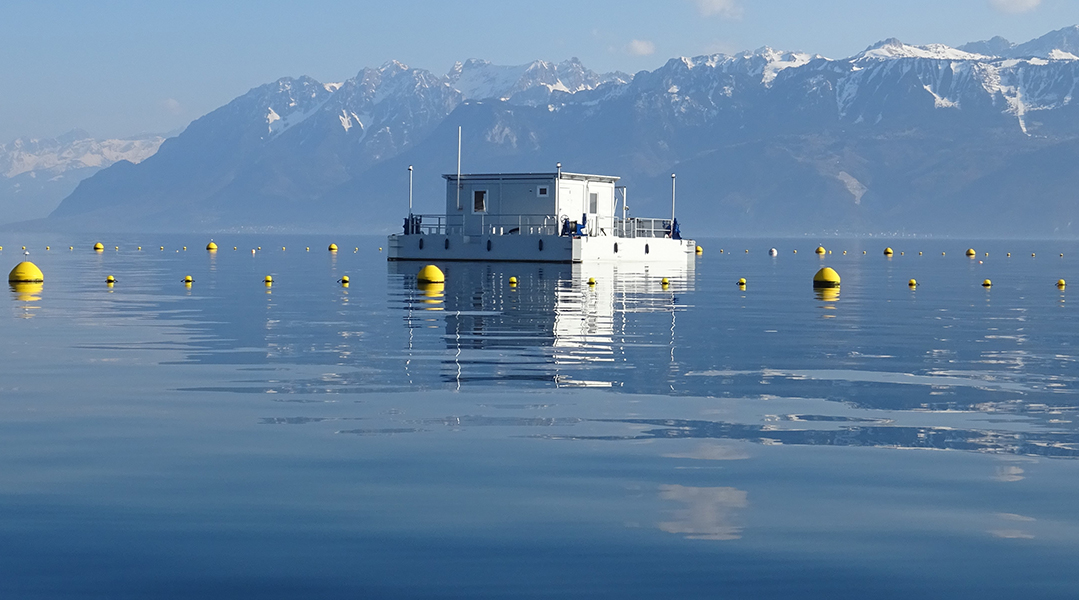Lakes are incredibly diverse systems both biologically and geologically. As such, studying them can offer scientists a comprehensive understanding of different geological, environmental, and biological issues.
In order to research lakes (a field called “limnology”), scientists rely on an array of observations across varying degrees of time and space — from years and meters to seconds and millimeters. While traditional limnology is done by boat sampling and instruments placed in the water, these methods rely on moving samples from the lake to an inland lab. But a team of researchers in Switzerland are trying a new method to study Lake Geneva more effectively — with a lab floating on top of the water.
Why a floating platform?
One of the driving forces behind designing and implementing a floating platform was convenience. “A floating laboratory allows [us] to study the air-water interface and to investigate the lake surface from above,” said Johny Wüest.
Wüest is an environmental science professor researching aquatic systems from the Swiss Federal Institute of Technology in Lausanne, and a member of the platform’s scientific strategy team (called the “steering committee”). While LéXPLORE is not the first of its kind, it is incredibly unique.
Wüest acknowledged: “There are other anchored platforms, which are either smaller or have specific purposes.” However, in terms of its size, interdisciplinary applications, and level of comfort, LéXPLORE stands on its own.
What does the platform look like?
LéXPLORE is a 10 by 10-meter floating platform, anchored over 110 meters of water 570 meters from the coastline. These dimensions were chosen as it could represent the characteristics and behavior of the rest of the lake, not just the edges. “The distance to the shore was important to have ‘open water’ conditions,” explained Wüest.
“Enough depth is important to include also the cold and dark deep-water, where zooplankton and fishes are active and where the organic matter is decomposed.” 15,000 square meters around the lab is also protected for the launch of submersibles.
The inside of LéXPLORE is much like any other laboratory — a purposeful design to mimic land-based labs as closely as possible. Scientists can access sampling and measurement equipment, as well as prepare and treat biological and chemical samples. Electronic equipment for data logging, lake monitoring, and data transmission are safe inside LéXPLORE’s weatherproof interior. LéXPLORE also has overnight accommodations for long term projects. In fact, the most jarring difference between LéXPLORE and research stations on the mainland is the presence of a moonpool for access to the lake under protected and controlled conditions.
Current projects
The projects the crew of LéXPLORE are tackling run the gamut of limnology, from monitoring microalgae to studying contaminants. One of the current projects seeks to characterize the colonization of mussels in the lake. Quagga mussels are an invasive freshwater species that can disturb the delicate ecosystems located in lakes and rivers, such as the Great Lakes in the United States and the Dnieper River in the Ukraine.
Mussels are efficient filters for bodies of water, filtering small organic particles from the water. More specifically, quagga mussels have high filtration rates relative to other species of mussel, which reduces the amount of nutrients available for phytoplankton. Reduction in phytoplankton population has consequences further up the food web. LéXPLORE researchers are currently in the process of studying this relationship as the population of mussels grows, as well as how their methods of colonizing the lake changes at greater depths.
Two other projects — titled CARBOGEN and LéWALK — are studying the behavior of carbon and oxygen in the lake system, respectively. CARBOGEN seeks to more thoroughly understand the amount of dissolved carbon dioxide in the lake, with further investigation on how humans have affected that amount. Researchers behind this project are relying on water samples at different depths to supplement pre-existing carbon data in order to generate a complete picture of Lake Geneva’s dissolved carbon dioxide.
LéWALK involves collecting several measurements per day over the course of a year to quantify the production of oxygen in Lake Geneva. These measurements are collected with an autonomous device, called the WireWalker, that is propelled by waves. The researchers behind the project are specifically looking to study behavior of turbulent mixing in the lake, which facilitates the exchange of nutrients upwards from the deep with dissolved oxygen at the surface from the atmosphere. This exchange is being altered with the onset of climate change, and this project is looking to demonstrate how the WireWalker can be a cost-effective way to profile turbulent mixing.
LéXPLORE is currently conducting several different limnological projects, and researchers are invited to submit their research proposals to conduct their work on the platform. As climate change continues to affect lakes and the systems within them, LéXPLORE can offer researchers a unique vantage point to generate a more comprehensive understanding.
Reference: Alfred Wüest, et al., LéXPLORE: A floating laboratory on Lake Geneva offering unique lake research opportunities, WIREs Water (2021). DOI: 10.1002/wat2.1544

















